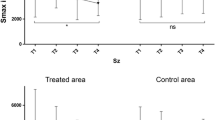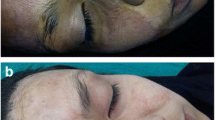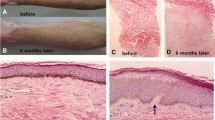Abstract
The tendency to use less-invasive laser-based methods with far more obvious effectiveness has been taken into consideration today for improvement of burning scars. The present study thus aimed to assess the efficacy of two laser-based techniques including pulsed dye laser (PDL) and ablative fractional CO2 laser (AFCL) and its combination on improving different aspects of burning scars regardless of the types of scar as hypertrophic or keloid scars. This randomized single-blinded clinical trial was performed on patients suffering hypertrophic or keloid burning scars. The patients were randomly assigned into three groups scheduling for treatment with PDL alone, AFCL alone, or its combination. All patients were visited before and 40 days after the last treatment session, and their scars were assessed. In all groups, significant improvement was revealed in the Vancouver scar scale (VSS) score, the color of scar, vascular bed in the scar, the and height of scar and its pliability; however, the improvement in each item was more highlighted in the group receiving a combination therapy with PDL and AFCL techniques. In this regard, the highest improvement was found in vascular bed and pliability in the combination therapy group as compared to other groups. Although the superiority of the combined group was not statistically significant, due to the high percentage of improvement in total VSS and most of its indicators, it can be clinically significant. The efficacy of the treatment protocols was different considering subgroups of mature and immature scars (less than 1 year), so that more improvement in pliability of scar, vascularity, and color of scar was found in the group scheduling for PDL + AFCL as compared to those who were treated with PDL alone in immature scar group but not in mature scar group. Combined treatment can be much more effective in improving the appearance and pathological characteristics of scars than each individual treatment. This effectiveness can be seen mainly in immature scars.



Similar content being viewed by others
Abbreviations
- PDL:
-
pulsed dye laser
- AFCL:
-
ablative fractional CO2 laser
- VSS:
-
Vancouver scar scale
References
Setoodehzadeh F, Ansari H, Zarei T, Surodi Z, Arbabi Z, Khammarnia M (2019) Factors affecting mortality in burn patients in the poorest region of Iran; a case control study. Int J Burns Trauma 9(3):66
Lawrence JW, Mason ST, Schomer K, Klein MB (2012) Epidemiology and impact of scarring after burn Injury: a systematic review of the literature. J Burn Care Res 33(1):136–146
Peck MD (2011) Epidemiology of burns throughout the world Part I: Distribution and risk factors. Burns 37(7):1087–1100
Gangemi EN, Gregori D, Berchialla P, Zingarelli E, Cairo M, Bollero D et al (2008) Epidemiology and risk Factors for pathologic scarring after burn wounds. Arch Fac Plast Surg 3:36–44
Wallace HJ, Fear MW, Crowe MM, Martin LJ, Wood FM (2017) Identification of factors predicting scar outcome after burn in adults: a prospective case–control study. Burns 43(6):1271–1283
Oosterwijk AM, Mouton LJ, Schouten H, Disseldorp LM, van der Schans CP, Nieuwenhuis MK (2017) Prevalence of scar contractures after burn: a systematic review. Burns 43(1):41–49
Finnerty CC, Jeschke MG, Branski LK, Barret JP, Dziewulski P, Herndon DN (2016) Hypertrophic scarring: the greatest unmet challenge after burn injury. Lancet 388(10052):1427–1436
Limandjaja GC, Niessen FB, Scheper RJ, Gibbs S (2021) Hypertrophic scars and keloids: overview of the evidence and practical guide for differentiating between these abnormal scars. Exp Dermatol 30(1):146–161
Bombaro KM, Engrav LH, Carrougher GJ, Wiechman SA, Faucher L, Costa BA et al (2003) What is the prevalence of hypertrophic scarring following burns? Burns 29(4):299–302
O’Brien L, Jones DJ (2013) Silicone gel sheeting for preventing and treating hypertrophic and keloid scars. Cochrane Database Syst Rev (9):176–184
Leblebici B, Adam M, Bağiş S, Tarim AM, Noyan T, Akman MN et al (2006) Quality of life after burn injury: the impact of joint contracture. J Burn Care Res 27(6):864–868
Azzam O, Bassiouny D, El-Hawary M, El Maadawi Z, Sobhi R, El-Mesidy M (2016) Treatment of hypertrophic scars and keloids by fractional carbon dioxide laser: a clinical, histological, and immunohistochemical study. Lasers Med Sci 31:9–18
Daoud AA, Gianatasio C, Rudnick A, Michael M, Waibel J (2019) Efficacy of combined intense pulsed light (IPL) with fractional CO2-laser ablation in the treatment of large hypertrophic scars: a prospective, randomized control trial. Lasers Surg Med 51(8):678–685
Hersant B, SidAhmed-Mezi M, Picard F, Hermeziu O, Rodriguez A-M, Ezzedine K et al (2018) Efficacy of autologous platelet concentrates as adjuvant therapy to surgical excision in the treatment of keloid scars refractory to conventional treatments: a pilot prospective study. Ann Plast Surg 81(2):170–175
McGoldrick RB, Sawyer A, Davis CR, Theodorakopoulou E, Murison M (2016) Lasers and ancillary treatments for scar management: personal experience over two decades and contextual review of the literature. Part I: Burn scars. Scars Burns Heal 2:2059513116642090
Ouyang HW, Gf Li, Lei Y, Gold MH, Tan J (2018) Comparison of the effectiveness of pulsed dye laser vs pulsed dye laser combined with ultrapulse fractional CO 2 laser in the treatment of immature red hypertrophic scars. J Cosmet Dermatol 17(1):54–60
Allison K, Kiernan M, Waters R, Clement R (2003) Pulsed dye laser treatment of burn scars: alleviation or irritation? Burns 29(3):207–213
Shin J, Cho JT, Park SI, Jung SN (2019) Combination therapy using non-ablative fractional laser and intralesional triamcinolone injection for hypertrophic scars and keloids treatment. Int Wound J 16(6):1450–1456
Wittenberg GP, Fabian BG, Bogomilsky JL, Schultz LR, Rudner EJ, Chaffins ML et al (1999) Prospective, single-blind, randomized, controlled study to assess the efficacy of the 585-nm flashlamp-pumped pulsed-dye laser and silicone gel sheeting in hypertrophic scar treatment. Arch Dermatol 135(9):1049–1055
Chowdhury B, Kassir M, Salas-Alanis J, Nistico S, Galadari H, Fritz K et al (2021) Laser in surgical scar clearance: an update review. J Cosmet Dermatol 20(12):3808–3811
Yang Q, Ma Y, Zhu R, Huang G, Guan M, Avram MM et al (2012) The effect of flashlamp pulsed dye laser on the expression of connective tissue growth factor in keloids. Lasers Surg Med 44(5):377–383
Brewin M, Lister T (2014) Prevention or treatment of hypertrophic burn scarring: a review of when and how to treat with the pulsed dye laser. Burns 40(5):797–804
Davari P, Gorouhi F, Hashemi P, Behnia F, Ghassemi A, Nasiri-Kashani M et al (2012) Pulsed dye laser treatment with different onset times for new surgical scars: a single-blind randomized controlled trial. Lasers Med Sci 27:1095–1098
Alster TS, Lewis AB, Rosenbach A (1998) Laser scar revision: comparison of CO2 laser vaporization with and without simultaneous pulsed dye laser treatment. Dermatol Surg 24(12):1299–1302
Matuszczak E, Weremijewicz A, Koper-Lenkiewicz OM, Kamińska J, Hermanowicz A, Dębek W et al (2021) Effects of combined pulsed dye laser and fractional CO2 laser treatment of burn scars and correlation with plasma levels of collagen type I, MMP-2 and TIMP-1. Burns 47(6):1342–1351
Roohaninasab M, Khodadad F, Sadeghzadeh-Bazargan A, Atefi N, Zare S, Jafarzadeh A et al (2023) Efficacy of fractional CO(2) laser in combination with stromal vascular fraction (SVF) compared with fractional CO(2) laser alone in the treatment of burn scars: a randomized controlled clinical trial. Stem Cell Res Ther 14(1):269
Xie W, Lei F, Wang J, Xu J, Ruan J, Li Z (2018) Clinical effects of sequential laser treatments on early stage hypertrophic burn scars. Zhonghua Shao Shang Za Zhi= Zhonghua Shaoshang Zazhi= Chin J Burns 34(9):615–623
Lei Y, Ouyang H, Tan J (2020) Effect of pulsed dye laser in combination with ultra-pulsed fractional carbon dioxide laser in treating pediatric burn scars at early stage. Zhonghua Shao Shang Za Zhi= Zhonghua Shaoshang Zazhi= Chin J Burns 36(5):357–362
Acknowledgements
The authors would like to thank the staff of the Rasool Akram Medical Complex Clinical Research Development Center (RCRDC) and the Dermatology and Stem Cell Research Center of Tehran University of Medical Sciences for their technical assistance in writing, editing, and improving quality of the paper.
Author information
Authors and Affiliations
Contributions
A.G. conceived the manuscript topic and developed the study design. M.K.K. and A.J. conducted the data collection and interpretation of results as well as drafted the final manuscript. F.S.B. and S.S. performed the data analysis. M.K.K., A.J., and A.G. reviewed and commented on the final and revised manuscript draft. M.K.K. and A.J. contributed in finalizing the revised paper. All authors read and approved the final manuscript.
Corresponding author
Ethics declarations
Conflict of interest
The authors declare no competing interests.
Additional information
Publisher's Note
Springer Nature remains neutral with regard to jurisdictional claims in published maps and institutional affiliations.
What is already known about this topic?
Laser therapy holds a unique role in the treatment of skin lesions.
particularly hypertrophic and keloid scars.
with two notable laser types being pulsed dye laser (PDL) and ablative fractional laser (AFCL).
Despite the fact that the effectiveness of each of the above lasers has been demonstrated in the literature.
there is a limited number of comprehensive clinical studies comparing the effectiveness of using the combination of these two lasers versus using each one individually.
What does this study add?
We demonstrated that although each of the targeted techniques improved different characteristics of scars.
the combination therapy was more effective and resulted in higher overall patient satisfaction compared to using PDL and fractional CO2 techniques alone.
We also made an interesting finding that the combined treatment of lasers showed significantly better results in treating immature scars compared to other types of scars.
Rights and permissions
Springer Nature or its licensor (e.g. a society or other partner) holds exclusive rights to this article under a publishing agreement with the author(s) or other rightsholder(s); author self-archiving of the accepted manuscript version of this article is solely governed by the terms of such publishing agreement and applicable law.
About this article
Cite this article
Kivi, M.K., Jafarzadeh, A., Hosseini-Baharanchi, F.S. et al. The efficacy, satisfaction, and safety of carbon dioxide (CO2) fractional laser in combination with pulsed dye laser (PDL) versus each one alone in the treatment of hypertrophic burn scars: a single-blinded randomized controlled trial. Lasers Med Sci 39, 69 (2024). https://doi.org/10.1007/s10103-024-03976-6
Received:
Accepted:
Published:
DOI: https://doi.org/10.1007/s10103-024-03976-6




